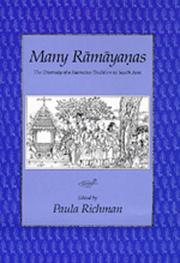| Listing 1 - 2 of 2 |
Sort by
|

ISBN: 0520072812 0520075897 052091175X 0585104441 9780520911758 9780585104447 9780520072817 9780520075894 Year: 1991 Publisher: Berkeley, CA : University of California Press,
Abstract | Keywords | Export | Availability | Bookmark
 Loading...
Loading...Choose an application
- Reference Manager
- EndNote
- RefWorks (Direct export to RefWorks)
Throughout Indian history, many authors and performers have produced, and many patrons have supported, diverse tellings of the story of the exiled prince Rama, who rescues his abducted wife by battling the demon king who has imprisoned her. The contributors to this volume focus on these "many" Ramayanas. While most scholars continue to rely on Valmiki's Sanskrit Ramayana as the authoritative version of the tale, the contributors to this volume do not. Their essays demonstrate the multivocal nature of the Ramayana by highlighting its variations according to historical period, political context, regional literary tradition, religious affiliation, intended audience, and genre. Socially marginal groups in Indian society--Telugu women, for example, or Untouchables from Madhya Pradesh--have recast the Rama story to reflect their own views of the world, while in other hands the epic has become the basis for teachings about spiritual liberation or the demand for political separatism. Historians of religion, scholars of South Asia, folklorists, cultural anthropologists--all will find here refreshing perspectives on this tale.
Indic literature --- Råama (Hindu deity) in literature --- Såitåa (Hindu deity) in literature --- Languages & Literatures --- Indo-Iranian Languages & Literatures --- History and criticism --- Rāma (Hindu deity) in literature. --- Rāma (Hindu deity) in literature. --- Sītā (Hindu deity) in literature. --- Sītā (Hindu deity) in literature. --- History and criticism. --- Kampar, --- Tulasīdāsa, --- Vālmīki. --- Rāma --- Sita --- In literature --- Seeta --- Seetha --- Siya --- Vaidehi --- Janaki --- Maithili --- Bhoomija --- Rāghava --- Ramachandra --- Ram
Book
ISBN: 9786611726515 1281726516 0253000157 9780253000156 6611726519 9781281726513 9780253349880 0253349885 9780253219534 0253219531 Year: 2008 Publisher: Bloomington Indiana University Press
Abstract | Keywords | Export | Availability | Bookmark
 Loading...
Loading...Choose an application
- Reference Manager
- EndNote
- RefWorks (Direct export to RefWorks)
Fresh perspectives on the classic Indiana epic
Dravidian literature --- Indic literature --- Vālmīki --- Wālmīki --- Bālmīki --- Wālamīki --- Wānmīki --- Vaalmeeki --- والميكى --- Vālmīki --- Valmiki
| Listing 1 - 2 of 2 |
Sort by
|

 Search
Search Feedback
Feedback About UniCat
About UniCat  Help
Help News
News